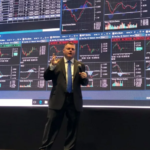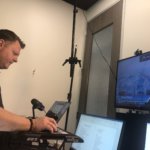¿QUIERES APRENDER TRADING?
Ahora puedes aprender las técnicas que David Story un ex-militar, emprendedor, empresario y creador de empresas de finanzas y tecnología, piloto y trader ha desarrollado.
Aprende la metodología que David Story usa todos los días para ser exitoso en el mercado de valores.
David ha impartido seminarios en Estados Unidos, México, el Caribe y Dubai.
¡Las plazas son limitadas así que regístrate lo antes posible para conseguir tu plaza!
DO YOU WANT TO LEARN TRADING?
Now you can learn the techniques developed by David Story ex-military, entrepreneur, businessman, creator of finance, technology companies, pilot and trader.
Learn the methodology that David Story uses every day to be successful in the stock market.
David has given seminars in the United States, Mexico, the Caribbean and Dubai.
Spots are limited so register as soon as possible to get a spot!
INFORMACIÓN / INFORMATION
Si te registras ahora puedes formar parte de esta conferencia de trading con una duración de 4 días.
El primer día se impartirá una INTRODUCCIÓN AL TRADING gratuita con diversos temas muy importantes para comenzar con buen pie en el mundo del trading, más abajo en esta página podrás revisar en detalle el amplio temario en el que profundizaremos.
Los días 2, 3 y 4 realizaremos nuestras MASTER CLASSES, una incursión a fondo en el mundo del trading. Estos tres días tendrán un coste de $1600 dólares ($32.000 pesos)*, aunque, si te registras online, recibirás un descuento de $400 dolares($8.000 pesos)*, con lo cual sólo tendrás que abonar $1200 dólares ($24.000 pesos)*. Recuerda que esto es sólo aplicable a las personas que se registren y paguen vía online.
Esta oferta se mantendrá hasta el día 28 de MARZO, un día antes de la conferencia, el cupo es limitado así que, ¡no te lo pierdas y regístrate ahora!.
*Los precios están en dólares americanos, aproximadamente hemos incluido y redondeado el precio en pesos mexicanos.
El horario de las conferencias de los días 29,30 y 31 de Marzo será de 16:00 a 21:00 y del día 1 de Abril será de 10:00 a 15:00
INFORMACIÓN / INFORMATION
If you register now you can be part of our 4 day trading conference.
The first day there will be a free INTRODUCTION TO TRADING with various important topics to start off on the right foot in the world of trading. Further down on this page you can review in detail the wide topic in which we will divulge.
On days 2, 3 and 4 we will carry out our MASTER CLASSES, an in-depth foray into the world of trading. These three days will cost $1,600 dollars ($32,000 pesos), although if you register online, you will receive a discount of $400 dollars ($8,000 pesos), which is $1,200 dollars ($24,000 pesos)*.Remember that this is only applicable to people who register and pay online.
This offer will be maintained until MARCH 28, one day before the conference, space is limited so, don’t miss and lose out and register now!.
*Prices are in US dollars, approximately we have included and rounded the price in Mexican pesos.
The schedule for the conferences on March 29, 30 and 31 will be from 4:00 p.m. to 9:00 p.m. and on April 1 will be from 10:00 a.m. to 3:00 a.m.
TEMARIO
SYLLABUS
Pasos para registrarte en el evento:
- Elegir tipo de ticket entre participar únicamente en el primer día gratuito del curso o bien elegir asistir a todas las conferencias.
- Seleccionar el número de tickets, en el caso de que quieras registrar y asistir con alguien más al evento.
- Rellenar el formulario por cada participante: Nombre, Correo electrónico, Teléfono y ciudad de la que vienes.
- Pulsar el botón Continuar el registro.
- Rellenar los datos de la persona que realiza el pedido: Nombre, País, Dirección, Ciudad, Código postal, Teléfono, Correo electrónico, En el caso de querer crear una cuenta, marca la casilla Create an account
- Revisa los detalles del pedido
- En caso de haber escogido la opción de asistencia completa, deberás rellenar el formulario de pago con los datos de la tarjeta de crédito:
- Escoge entre Tarjeta de crédito(VISA/MASTERCARD) o E-Check
- En caso de seleccionar tarjeta
- Selecciona el tipo de tarjeta
- Nombre
- Apellidos
- Número de la tarjeta(sin carácteres adicionales, únicamente las cifras)
- Fecha de expiración de la tarjeta(MM/YY), dos cifras para mes y dos cifras para el año.
- CVC(Código de seguridad de la tarjeta)
- País de origen de la tarjeta de crédito.
- Pulsar sobre el botón “Place Order” para Realizar el pedido.
Steps to register for the event:
- Choose ticket type to participate only in the first free day of the course or choose to attend all the lectures.
- Select the number of tickets, in case you want to register and attend the event with someone else.
- Fill in the form for each participant: Name, Email, Phone and city you are coming from.
- Click on the “Continue registration” button.
- Fill in the details of the person placing the order: Name, Country, Address, City, Zip Code, Phone, Email, In case you want to create an account, check the Create an account box.
- Check the order details
- If you have chosen the full support option, you will need to fill in the payment form with your credit card details:
- Choose between Credit Card(VISA/MASTERCARD) or E-Check.
- If you choose credit card
- Select the type of card
- Name
- Last name
- Card number (no additional characters, only digits)
- Card expiration date (MM/YYY), two digits for month and two digits for year.
- CVC(Card Security Code)
- Country of origin of the credit card.
- Click on the “Place Order” button to place the order.





